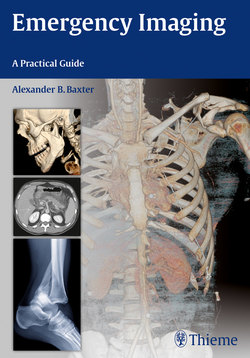Читать книгу Emergency Imaging - Alexander B. Baxter - Страница 23
На сайте Литреса книга снята с продажи.
Оглавление9
2
Br
ain
aneurysms, arteriovenous malformations (AVM), vascular injuries, and venous or cavernous sinus thrombosis. Conventional angiography is usually reserved for preop-erative aneurysm or AVM evaluation, and endovascular therapy. CT perfusion imag-ing can be useful in identifying the location and extent of vascular compromise in pa-tients with acute stroke symptoms.
On older scanners, brain CT is usually obtained nonhelically to avoid artifacts. Newer multislice CT systems permit ad-equate imaging of the brain in three planes as well as simultaneous acquisition of high-resolution images of the face and cer-vical spine in patients with acute head and neck trauma.
Checklist
• Scalp
• Skull
• Epidural space (potential)• Subdural space (potential)
• Dural sinuses and reflections
• Cortex
• Subcortical white matter
• Basal ganglia
• Ventricles
• Cisterns
• Cerebral vessels
• Pituitary and sella turcica
• Skull base
• Orbits
• Sinuses
• Facial bones
◆Approach
Noncontrast head CT is one of the most frequently ordered emergency studies. Common indications include headache, suspected cerebral infarct or intracerebral hemorrhage, altered mental status, and trauma.
Images should always be evaluated with windows and reconstruction algorithms optimized for brain, subdural hematoma, and bone. In trauma, multidetector CT from the skull base to the upper thoracic spine can be acquired to image the head, cervical spine, face, and skull base in a single scan. Thin-section reconstructions and reformations in multiple planes or three-dimensional surface renderings can then be extracted from the imaging data obtained.
Noncontrast CT is the initial study for detection of hemorrhage, infarct, intra-cranial masses, traumatic injuries, and assessment of overall brain volume and quality. A normal noncontrast CT excludes most emergent and surgical conditions. MRI with gadolinium is more sensitive for detection of infectious or neoplastic con-ditions including metastases, cerebritis, meningitis, and leptomeningeal neoplasm, but it is not typically necessary for acute management. Contrast CT is an alternative if MRI is not available or contraindicated in a particular patient.
Cerebral CT angiography, in which im-ages are obtained during the arterial or early venous phase of contrast enhance-ment, has largely replaced catheter angi-ography for primary detection of cerebral
